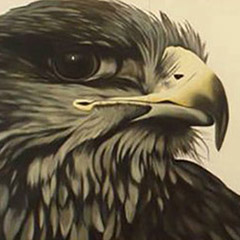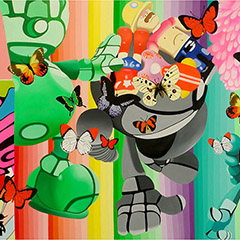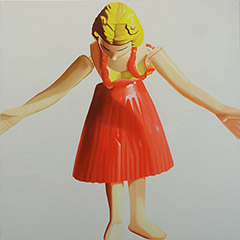Sin palabras. Centro Cultural Recoleta
Ciudad de Buenos Aires, Argentina. Curator & text: Renato Rita, 2008
Sin palabras [Speechless], by Renato Rita
Since Keep it clean, her first individual exhibition with women cleaning their houses obsessively, Cynthia Cohen describes the complex universe of female subjectivity. In Sin palabras, the exhibition she is presenting today, the artist sets aside the geometrical rigor of those starts and chooses a sarcastic tone based on parody humor. In this regard, she resorts to the language used by her master Pablo Suarez to comment with no concessions on the exaggerated waist movement that apparently must be made in order not to fall from the map and continue playing. This is how her Movimiento exagerado para la conquista [Exaggerated Movement for Conquer] emerged, a 2-meter work that is almost a mural, where a woman bends as much as she can to obtain the so desired look of a being that sometimes only exists in the virtual imaginary of a text message. A leap results from such unbending and, just like a leaf in the wind, her characters start to flutter around among color brush-strokes. The choice of the humor tone allows her to avoid the critical discourse and stand back from any complaint. Laughter, in its universal nature, has always been a powerful weapon to temporarily abolish hierarchical relations of oppressive systems. Even from the subtle prison we create ourselves. The humor ambivalence allows the artist to set a judgment about the reality commented in an oblique, distanced fashion, with a reinvigorating strength that makes the spectator reflect deeply about what he considers fun at a first instance. There is a climate of pop psychodelia across the exhibition, which was painted with the inspiration of music and movement—2 pillars—, made evident in the backgrounds, which seem to be chaotic but very accurate. Figures stand out in a close up of such whirlwind and are detached owing to the intensity of desire in its multiple pirouettes to try to adapt, reconcile, belong and be accepted.
For Cohen, the word today is the image. And the subject is freedom.
Dolls fly but are not confused, they come back to another place changing the mask, unbent, but always resembling themselves in the way they exercise their power to move and change. And when you see the exhibition you think whether all those possibilities of the being cannot live all together inside you, like in El gusanito [The Little Worm] by Jorge de la Vega, who, in the sixties, had already understood that “the world is meaningful if you look at it being determined, all together and at once, and if life cannot be divided: one piece the right side and the other upside down”.
Laura Batkis
“I saw that all labor and success spring from a man’s envy of his neighbor. This too is futile and a pursuit of the wind”.
Ecclesiastes (IV)
Ephemeral, like beauty in a thought, is every work we go over but does not make us feel moved; until this happens and becomes eternal. We could maybe conceive spontaneous graffiti on an imaginary wall in Cartago where we would read: “it is always the same thing”.
Cynthia is accurate when building such consideration by joyfully posing the worrying question that beauty, when present, forces us to make: Am I still here?
Renato Rita, 2008




